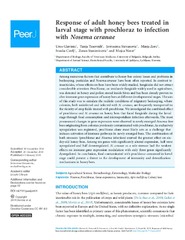Приказ основних података о документу
Response of adult honey bees treated in larval stage with prochloraz to infection with Nosema ceranae
| dc.creator | Glavinić, Uroš | |
| dc.creator | Tesovnik, Tanja | |
| dc.creator | Stevanović, Jevrosima | |
| dc.creator | Zorc, Minja | |
| dc.creator | Cizelj, Ivanka | |
| dc.creator | Stanimirović, Zoran | |
| dc.creator | Narat, Mojca | |
| dc.date.accessioned | 2020-06-03T14:33:29Z | |
| dc.date.available | 2020-06-03T14:33:29Z | |
| dc.date.issued | 2019 | |
| dc.identifier.issn | 2167-8359 | |
| dc.identifier.uri | https://vet-erinar.vet.bg.ac.rs/handle/123456789/1739 | |
| dc.description.abstract | Among numerous factors that contribute to honey bee colony losses and problems in beekeeping, pesticides and Nosema ceranae have been often reported. In contrast to insecticides, whose effects on bees have been widely studied, fungicides did not attract considerable attention. Prochloraz, an imidazole fungicide widely used in agriculture, was detected in honey and pollen stored inside hives and has been already proven to alter immune gene expression of honey bees at different developmental stages. The aim of this study was to simulate the realistic conditions of migratory beekeeping, where colonies, both uninfected and infected with N. ceranae, are frequently transported to the vicinity of crop fields treated with prochloraz. We investigated the combined effect of prochloraz and N. ceranae on honey bees that faced fungicide during the larval stage through food consumption and microsporidium infection afterwards. The most pronounced changes in gene expression were observed in newly emerged Nosema-free bees originating from colonies previously contaminated with prochloraz. As exclusively upregulation was registered, prochloraz alone most likely acts as a challenge that induces activation of immune pathways in newly emerged bees. The combination of both stressors (prochloraz and Nosema infection) exerted the greatest effect on sixday-old honey bees. Among ten genes with significantly altered expression, half were upregulated and half downregulated. N. ceranae as a sole stressor had the weakest effects on immune gene expression modulation with only three genes significantly dysregulated. In conclusion, food contaminated with prochloraz consumed in larval stage could present a threat to the development of immunity and detoxification mechanisms in honey bees. | en |
| dc.publisher | Peerj Inc, London | |
| dc.relation | info:eu-repo/grantAgreement/MESTD/Integrated and Interdisciplinary Research (IIR or III)/46002/RS// | |
| dc.relation | Slovenian Research Agency (ARRS)Slovenian Research Agency - Slovenia | |
| dc.relation | Ministry of Agriculture, Forestry and Food [L4 5522, BI-RS/16-17-010] | |
| dc.rights | openAccess | |
| dc.rights.uri | https://creativecommons.org/licenses/by/4.0/ | |
| dc.source | PEERJ | |
| dc.subject | Nosema | en |
| dc.subject | Prochloraz | en |
| dc.subject | Gene expression | en |
| dc.subject | Immunity | en |
| dc.subject | Apis mellifera | en |
| dc.subject | Colony loss | en |
| dc.title | Response of adult honey bees treated in larval stage with prochloraz to infection with Nosema ceranae | en |
| dc.type | article | |
| dc.rights.license | BY | |
| dcterms.abstract | Зорц, Миња; Главинић, Урош; Цизељ, Иванка; Стевановић, Јевросима; Нарат, Мојца; Тесовник, Тања; Станимировић, Зоран; | |
| dc.citation.volume | 7 | |
| dc.citation.spage | e6325 | |
| dc.citation.other | 7: e6325 | |
| dc.citation.rank | M21 | |
| dc.identifier.wos | 000458123100003 | |
| dc.identifier.doi | 10.7717/peerj.6325 | |
| dc.identifier.pmid | 30775168 | |
| dc.identifier.scopus | 2-s2.0-85063617242 | |
| dc.identifier.fulltext | https://vet-erinar.vet.bg.ac.rs/bitstream/id/699/1738.pdf | |
| dc.type.version | publishedVersion |

